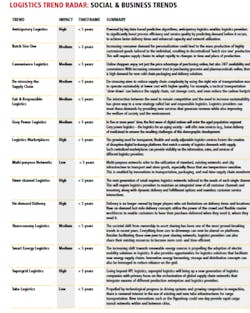DHL: Artificial intelligence will remold logistics world
Global logistics provider DHL believes worldwide supply chains are beginning to undergo a fundamental transformation as more “artificial intelligence” is deployed to handle both the domestic and international movement of goods
According to research conducted in support of its recent 2016 Logistics Trend Radar, DHL thinks the impact of data-driven and autonomous supply chains provides an opportunity for “previously unimaginable levels of optimization” in manufacturing, logistics, warehousing and last mile delivery that could become a reality in less than half a decade, despite high set-up costs deterring early adoption within the logistics industry.
Matthias Heutger, senior vice president for strategy, marketing & innovation at DHL, said in a statement that 15 of the 26 “key trends” identified in the company’s annual trend radar report “are likely to make an impact in under five years” and thus bear careful watching by the global logistics industry.
Some of those trends include:
- Machine-human interaction and collaboration: The use of augmented reality (AR) accessed via “smart glasses” is exceeding predicted levels of impact within the logistics sphere, DHL said. Mainly adopted for order picking in logistics (also known as “vision picking”) smart glasses enable intelligent, hands-free operations. DHL noted that a pilot program it conducted with computer printer maker Ricoh in the Netherlands showed a 25% efficiency increase as well as strong positive feedback from the users.
- Robotics and automation: Next-generation robots are lighter, more flexible, easier to program, and more affordable. DHL noted it successfully tested “collaborative robots” that work side-by-side with human employees, supporting repetitive and physically demanding tasks in logistics.
- Self-driving vehicles: They’ve already made inroads in logistics, with autonomous forklifts and other self-piloted equipment now “reaching a level of maturity” in warehouse operations, DHL said. The next step for self-driving vehicles in logistics will be to overcome regulatory and security challenges to deploy autonomous vehicles on public roads.
- Drones in the skies: Unmanned aerial vehicles (UAVs) or drones will still require a bit more time before mainstream adoption, the company said.
- 3D Printing: Some products may no longer be manufactured in large mass-production facilities and shipped around the globe. Instead, product designs will be digitized and transmitted to small factories closer to the customers, allowing for what DHL dubs “hyper-customization” of products and “batch size one” manufacturing – all requiring new logistics service concepts.
While the “Internet of Things” or “IoT” will also play a large role in more “intelligent supply chains” as well – a trend DHL noted in its trend report last year – security concerns regarding hacking, among other issues, is slowing down its adoption.
IoT offers the potential to connect virtually anything to the Internet and accelerate data-driven logistics, DHL stressed; estimating that by 2020, more than 50 billion objects will be connected to the Internet, presenting an “immense” $1.9 trillion opportunity in logistics, by its reckoning.“Only a few logistics [IoT] applications with substantial business impact have materialized so far,” DHL noted in its report. “This is largely due to a shortage of standards in the industry, security concerns, and the fact that recent IoT innovations have mainly been developed for the consumer market. Therefore, logistics will have to wait until similar ruggedized versions that meet business requirements come to market.”
The company added that high-profile data breaches and hacking of data systems as well as even physical objects – such as cameras and self-driving cars – are a reminder of growing security vulnerabilities in the “digitalized” world.
“In increasingly IT [information technology] rich supply chains, eliminating security risks has become a top priority to avoid harmful attacks that could bring entire operations to a standstill,” DHL stressed. “This mounting security awareness is in turn decelerating the adoption of cloud logistics, despite its substantial cost and efficiency benefits.”
In parallel, continued global market volatility and regional instability have led to tightened security regulations that require higher levels of supply chain transparency and integrity, the company noted in its report
“As a reaction to this, companies are weighing security against risk, increasingly de-stressing the supply chain by making tactical ‘slow-downs’ that prioritize operational security over speed,” DHL emphasized.
About the Author
Sean Kilcarr
Editor in Chief
Sean Kilcarr is a former longtime FleetOwner senior editor who wrote for the publication from 2000 to 2018. He served as editor-in-chief from 2017 to 2018.

